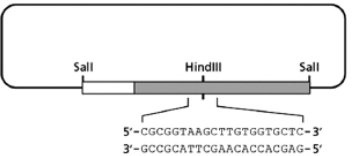You have created a piece of recombinant DNA by placing a cDNA from a gene you believe is important for the differentiation of liver cells (called LC1) onto an expression plasmid that contains all the sequences necessary for propagation of this DNA in bacteria and for the production of the LC1 protein in bacteria.A picture of this plasmid is shown in Figure 10-66A, with the segment of the DNA containing the LC1 gene depicted as a gray rectangle; the promoter sequence is depicted as a white rectangle.The LC1 protein is phosphorylated on serine 54; the nucleotide sequence of the portion of the DNA that encodes this region is shown below the diagram.All HindIII and SalI restriction sites have also been mapped on the plasmid; the recognition sequences for these restriction nucleases are shown in Figure 10-66B.
Table 10-56 (A)
(B)
Figure 10-66
A.Given the information above, write out the amino acids 52 to 57, encoded by the nucleotide sequence shown above.Be sure to number the amino acids appropriately.(Hint: Remember, serine is amino acid number 54.)
B.You want to create a mutant version of the LC1 gene that replaces the serine 54 found on this peptide with a glycine.You want to do this by changing only one nucleotide, and you also want to destroy the HindIII recognition sequence with this change.Write out a 21-nucleotide DNA sequence that can accommodate these changes.Be sure to (i) write out the DNA and label the 5′ and 3′ ends, (ii) underline the mutated HindIII recognition site, and (iii) circle any change made to the original sequence.
Definitions:
Ego Integrity
A sense of coherence and wholeness that one experiences upon reflecting on their life, typically achieved in late adulthood, according to Erikson's stages of psychosocial development.
Irrelevant
Not connected with or relevant to something.
Incomplete
A state of being not fully formed, finished, or lacking some parts.
Care
The provision of what is necessary for the health, welfare, maintenance, and protection of someone or something.
Q15: You are interested in studying the
Q16: Most animal fats form a solid at
Q20: Where are chloroplast proteins translated?<br>A)in the cytosol<br>B)in
Q27: You have been asked to consult
Q34: You are curious about the dynamic instability
Q34: Methylation and acetylation are common changes made
Q36: You prepare bacterial cell extracts by lysing
Q38: Consider a redox reaction between molecules A
Q48: One of the key features of living
Q65: Based upon what you know about metabolism,